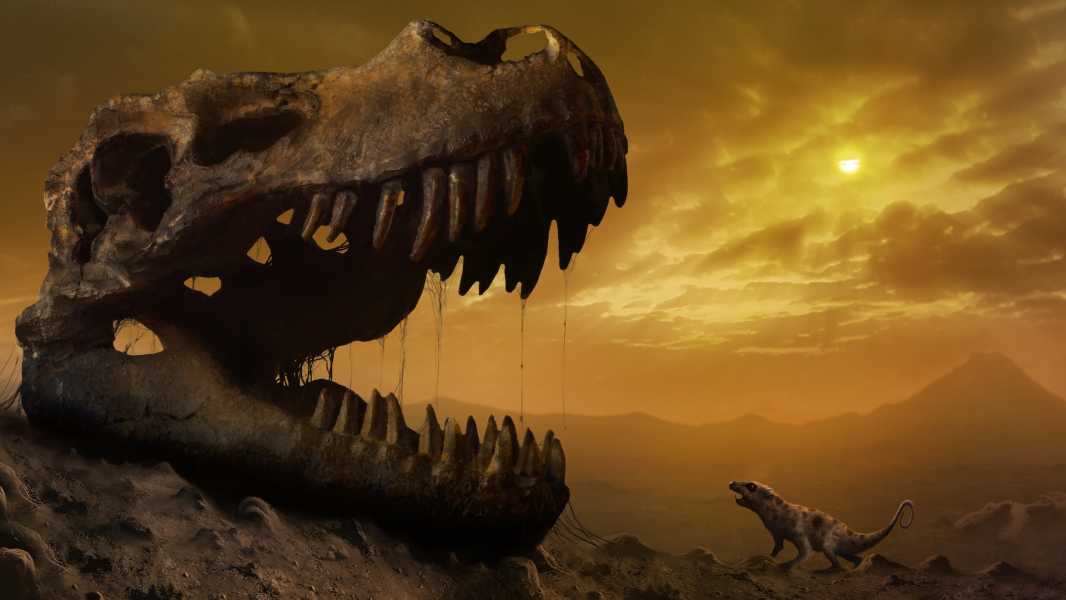
A catastrophic asteroid impact 66 million years ago wiped out 75% of species on our planet, including non-avian dinosaurs. (Image credit: MARK GARLICK/SCIENCE PHOTO LIBRARY via Getty Images)
One fateful day 66 million years ago, dinosaurs, who had been on Earth for about 165 million years, got a nasty surprise: An asteroid about 9 miles (15 kilometers) across struck what is now Mexico, causing tsunamis, wildfires, and acid rain, as well as causing a huge amount of debris to blot out the sun. As a result, 75 percent of Earth’s species, including non-avian dinosaurs, became extinct within months of the impact.
But what if the asteroid had not hit Earth? Would dinosaurs have continued to dominate the planet? Would they have been able to survive the ice ages and evolve to become more intelligent?
Palaeontologists say it’s entirely possible that dinosaurs could have continued to evolve and remain dominant on Earth. After all, they had already survived and adapted for 165 million years, surviving sea level changes, temperature fluctuations and volcanic eruptions, says Steve Brusatte, professor of palaeontology at the University of Edinburgh. But that would have made it difficult for our mammal ancestors to evolve in the way they did.
Some researchers believe that dinosaurs would have died out anyway, since extinctions seem to have preceded the emergence of new dinosaur species. But Brusatte disagrees.
“It’s pretty clear to us who study the fossil record of the last dinosaurs that everywhere in the world … there was a huge diversity and abundance of dinosaurs,” Brusatte told Live Science in an email. “It seems pretty clear to me that dinosaurs were strong, successful, still diverse, and still at the top of their evolutionary chain when the asteroid hit.”
Dinosaurs in the Ice Age?
But could dinosaurs survive in cold conditions, such as during ice ages? With the exception of a few dinosaurs that lived in snowy climates, most would not have survived. According to Brusatte, certain dinosaurs could have successfully adapted to new extreme conditions.
“Many of them had feathers, [so] they could insulate themselves in the same way that mammals do,” Brusatte explained. Additionally, some dinosaurs, like Tyrannosaurus rex, were likely warm-blooded, which suggests research suggests they weren’t completely susceptible to climate change.
It is also possible that dinosaurs developed new ways to protect themselves from the cold in extreme weather conditions. For example, mammoths evolved around 5 million years ago in South Africa and some developed fur around 800,000 years ago, during the last ice age, when they spread into the much colder region of Eurasia.
Could dinosaurs have become more intelligent?
Given enough time, could dinosaurs have evolved into more intelligent creatures? In a 1982 thought experiment, American-Canadian paleontologist Dale Russell wondered whether troodontids might have developed sentience if they had not died out in the end-Cretaceous mass extinction. He dubbed them humanoid dinosaurs, or dinosauroids. He based this concept on the fact that one species of troodontid already had “a large brain, stereoscopic vision, opposable digits, and a bipedal stance,” and could have evolved to “an encephalization quotient similar to that of Homo sapiens” if it had survived. His colleague Ron Seguin, an artist and model maker, made a reconstruction depicting the creature with green skin.
Sourse: www.livescience.com





